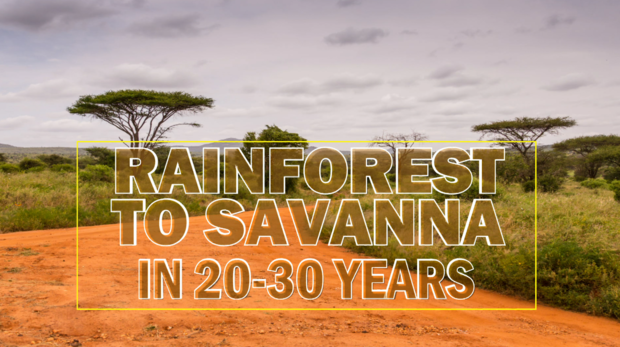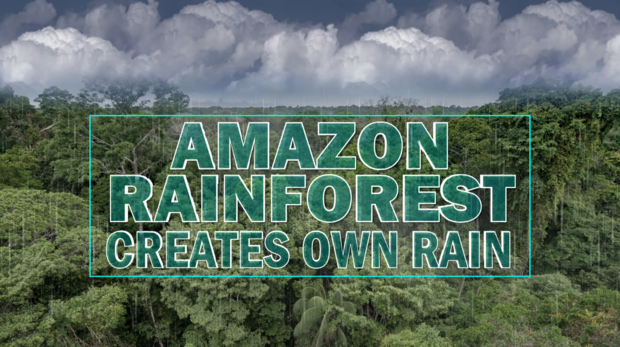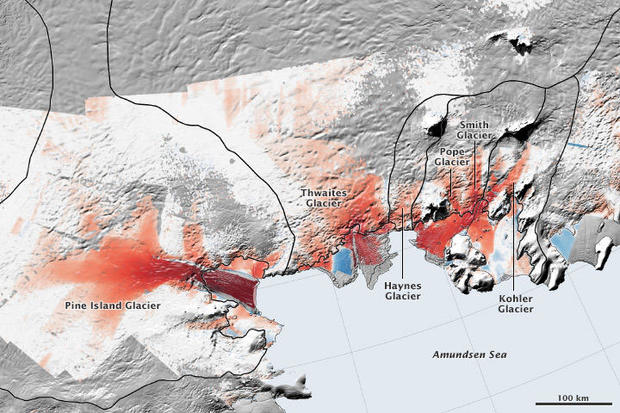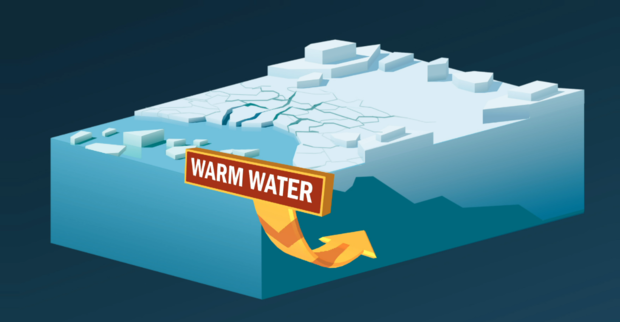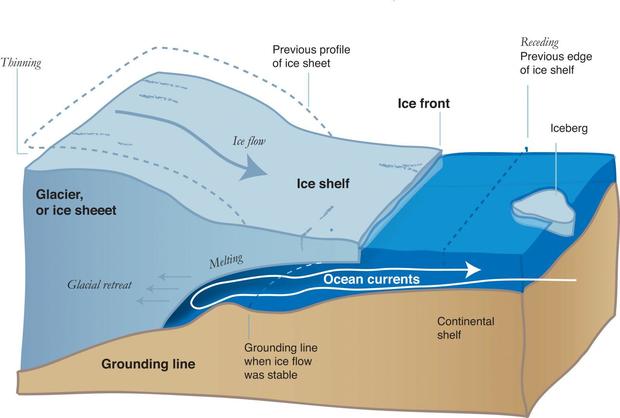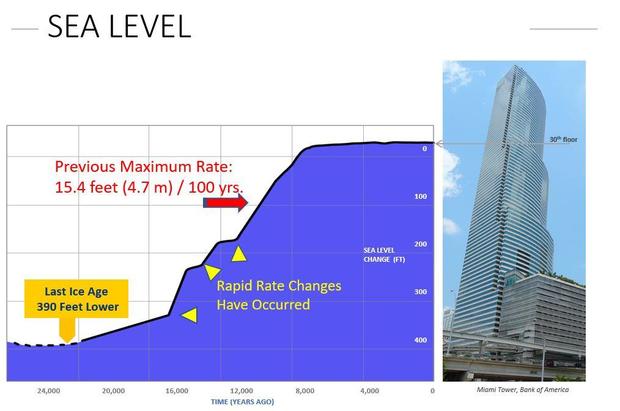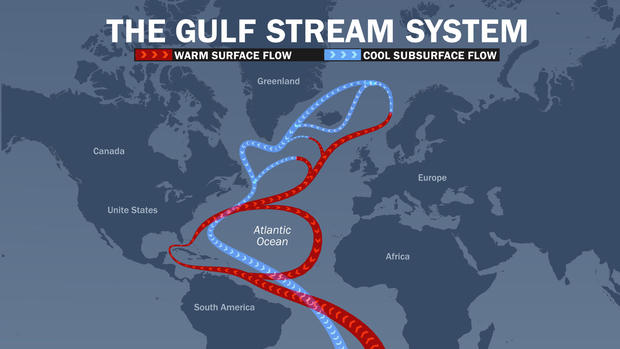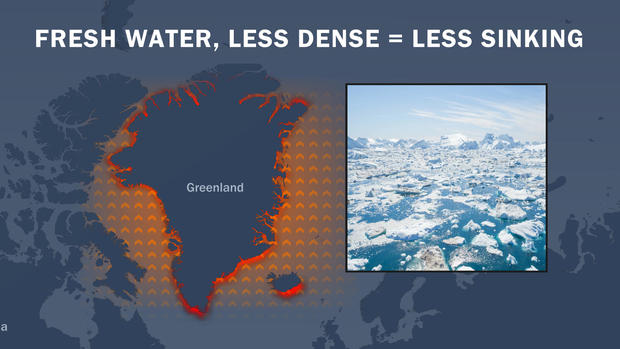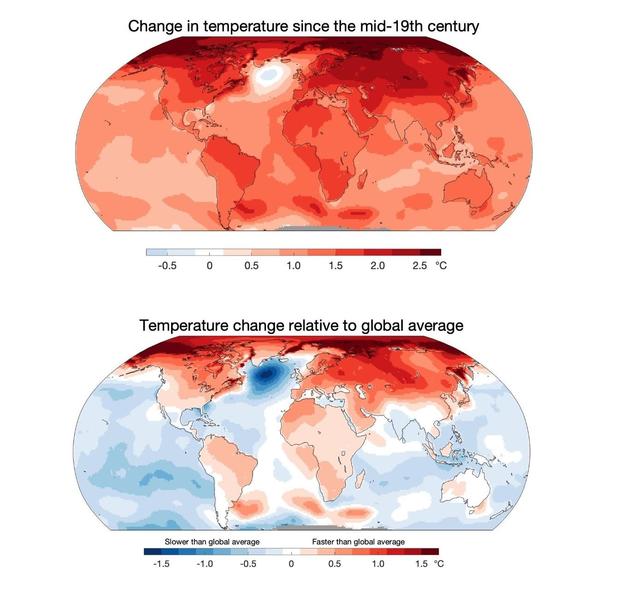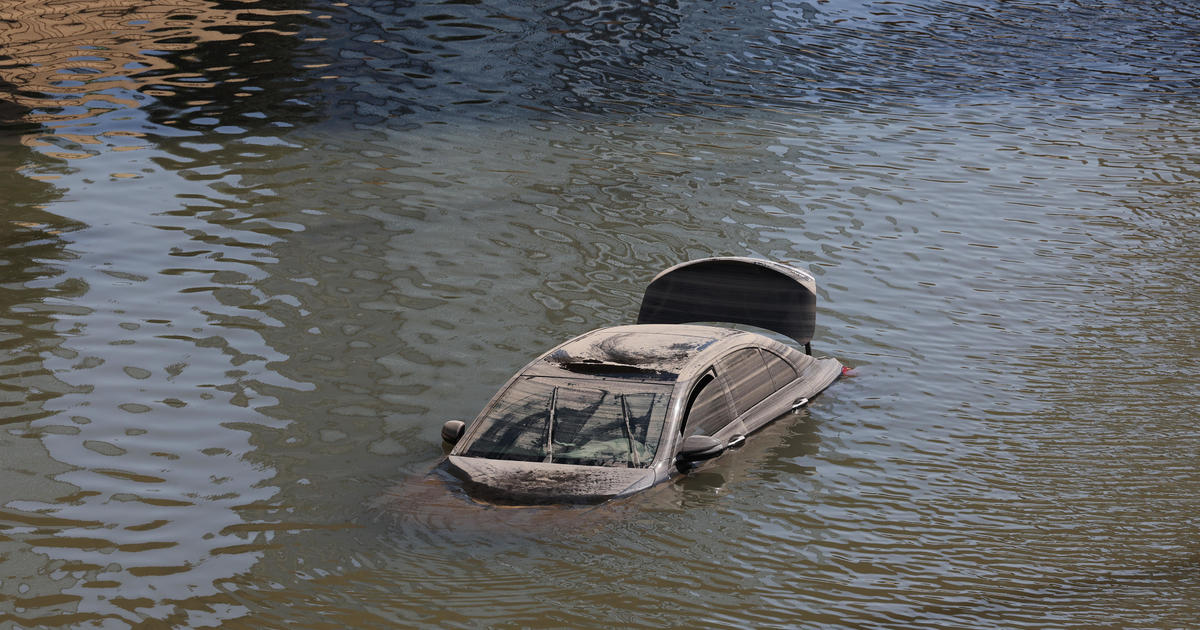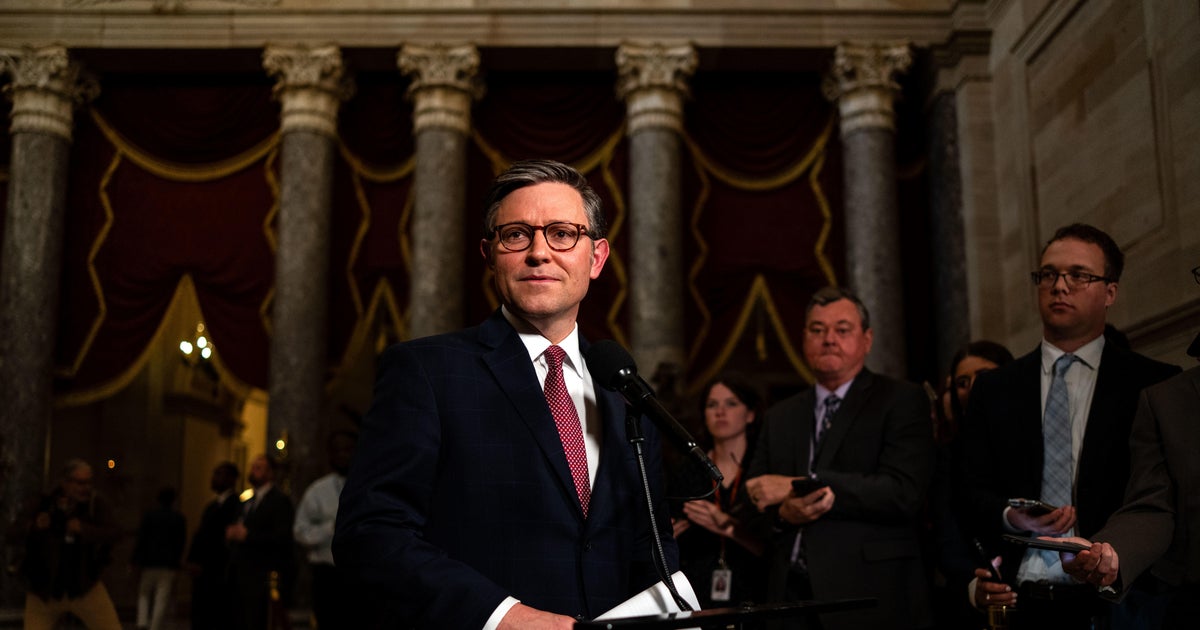Climate tipping points may have been reached already, experts say
Through decades of research, and now lived experience, it has become clear that the impacts of climate change will have drastic and far-reaching consequences on our planet. And while some of those consequences are predictable — like more extreme weather, sea-level rise and loss of biodiversity — the pace at which these unfold and their eventual severity hinge on what happens with key linchpins in the climate system, called tipping points.
A tipping point is a threshold or point of no return in the climate system that once passed can no longer be reversed. Passing a tipping point does not necessarily mean immediate, drastic consequences, but it does mean those consequences become unavoidable, and over time the impacts may be dramatic.
In a 2019 paper, Professor Timothy Lenton, a global leader on the subject, identified nine climate tipping points, from melting permafrost in the Arctic to the loss of tropical coral reefs. Here we will focus on what he deems the three most critical tipping points: the Amazon rainforest, the West Antarctic ice sheet and the Gulf Stream system.
Lenton highlights these three because the West Antarctic ice sheet may have already passed a tipping point; the Amazon because it is a crucial crucible of biodiversity and for its warehouse of carbon; and the Gulf Stream system because of its potential for profound changes with connected ramifications all around the planet.
CBS News spoke to Lenton and several other scientists about the state of climate tipping points. While they have different areas of expertise, ranging from oceans to atmosphere to biosphere, their message was unanimous: Changes are happening faster than what was expected and the chance of hitting tipping points in the climate system, which just a decade ago appeared remote and far off, now seems much more likely and more immediate.
"This is why I have been raising the alarm," Lenton said. "In just a decade the risk level has gone up markedly — that should be triggering urgent action."
The Amazon rainforest
For 55 million years the Amazon rainforest has weathered all of nature's ups and downs, but just one century of human negligence — a geological blink of an eye — threatens to be the nail in the coffin for this ancient forest.
The Amazon is huge — almost the size of the contiguous United States. Home to an estimated 3 million species, about 10% of the Earth's known biodiversity, and half of the planet's remaining rainforest, the Amazon is among the most diverse places on Earth. But many experts believe the Amazon may have already entered tipping point territory.
Having studied the Amazon for 56 years and visited hundreds of times, Dr. Thomas Lovejoy is one of those experts.
"We are really right at that tipping point. We see the signs in longer dry seasons, hotter dry seasons, tree species that prefer drier conditions gaining dominance over those that prefer wet conditions," explains Lovejoy, a professor at George Mason University and founder of the Amazon Biodiversity Center. "So we know that it's right there at the tipping point right now."
When Lovejoy started studying the Amazon in the 1960s, 10 million people lived there and the forest was 97% intact. Now there are 30 million people living there and deforestation in the Brazilian Amazon is at 20% — the critical level at which scientists believe the Amazon starts to tip towards the point of no return, where it no longer survives as a lush wet rainforest and transitions into an arid savanna.
Lovejoy says this transition from rainforest to savanna could happen as fast as a mortgage cycle. "I would say it's a matter of something that happens on the timescale of decades like 10, 20, 30 years, not centuries. So, a lot of the people alive today would actually get to see that negative consequence."
Lenton is less sure. "I wish I knew how close we are to a tipping point," he said. But he agrees the signs are pointing in that direction.
"We have work submitted showing early warning signs that the whole forest is losing resilience. I'd say that for the drier southeast side of the Amazon it is already under serious risk of fire-amplified loss."
A rainforest is only a rainforest because it is a rain-making machine — generating 50% of its own rainfall. That phenomenon is made possible as the leaves that make up the canopy of trees exhale moisture upward (a process called evapotranspiration), condensing in the cooler air above and forming a river of clouds that rains the moisture back down.
"Just by watching what happens after a rainfall in the Amazon and afterwards you see plumes of moisture coming up out of the canopy of the forest and that all moves westward to become rainfall once again, " explains Lovejoy.
But as the trees disappear and the forest becomes fractured, so does the moisture. Lovejoy says this destruction is due to fires and deforestation from small landowners grabbing land and to large corporations engaged in industrial agriculture, mainly growing soybeans and supporting livestock.
In 2020, fires reached their highest number in a decade in the Brazilian Amazon and deforestation in the Amazon surged to its highest point in 12 years. Critics blame Brazil's President Jair Bolsonaro for looking the other way on enforcement of environmental regulations and even encouraging agriculture and mining activities, which undermine the health of the forest.
Since the 1980s, NASA has observed a significant increase in something called the vapor pressure deficit (VPD) over the Amazon rainforest. The VPD is the difference, or gap, between the amount of moisture in the air and the amount it can hold. That gap is widening, which represents a drop in relative humidity, due to an increase in greenhouse warming from human-caused climate change and aerosols from biomass burning.
When the atmosphere is less humid, it has room for more moisture and it becomes more thirsty, pulling that moisture out of the ground and making the vegetation drier. This leads to more drought and is very similar to what is happening in California, which is making wildfires worse. Over the past century temperatures in the Amazon have risen by over 2 degrees Fahrenheit and in the past 50 years the dry season has expanded by a month.
Lovejoy says the impacts of a transition of the Amazon rainforest to a more arid savanna would be devastating both locally and globally. Locally, the 30 million people who live there, many of them Indigenous, depend on the reliable rainfall produced by the rainforest. Significant loss of rain means an escalation of drought that may be devastating to agriculture. A drier Amazon would also mean a significant loss in biodiversity — the extinction of unique creatures which only exist in that one region.
Globally, the Amazon rainforest is a tremendous repository for the planet's carbon, but if it becomes a savanna much of that carbon will be unleashed, magnifying climate change, "It does matter in a very, very big way in terms of the global carbon cycle and climate change," says Lovejoy.
He estimates the forest contains a staggering 100 billion tons of carbon in its lush vegetation and soils — equivalent to about three times the amount of greenhouse gases emitted from the burning of fossil fuels each year. If the Amazon crosses the tipping point, "It not only absorbs a lot less, but all the forest that is being replaced by grassland, all that carbon ends up in the atmosphere," Lovejoy warns.
Lovejoy says there is still hope we could stop this from happening, but the task is urgent. He says the nations which make up this unique ecosystem must cooperate and immediately work to reforest the Amazon.
"There is a very urgent priority to move to a point where we are actually collectively managing the Amazon as a sustainable system," he said.
West Antarctic ice sheet
Of all the threats posed by climate change, sea level rise is arguably the biggest. That's because with billions of people living along the world's coastlines, rapid sea-level rise will force massive disruption. Given the immense amount of heat already absorbed in the ocean system due to human-caused climate change, there's no doubt several feet — and likely much more — of sea level rise is already locked in, but the question is how fast will it happen?
The latest research finds that global warming thresholds that would trigger tipping points on both the Greenland and Antarctic ice sheets are not that far away. The authors of a 2018 study find that these tipping points will likely occur between 1.5 and 2 degrees Celsius of global warming above pre-industrial levels — the level at which the Paris Climate Agreement aims to halt warming. The Earth has already warmed by 1.2 degrees, and 1.5 degrees of warming may be less than 15 years away.
Because of the complexity of ice sheet dynamics, it is hard to know exactly when a tipping point will be reached, but Lenton warns we may already be there: "It is plausible we are already past a tipping point."
With ice more than a mile thick and a size almost double the contiguous United States, the Antarctic landmass holds enough ice to raise sea levels by 200 feet. For decades it was assumed the frigid Antarctic ice sheet was fairly stable, so most glacier headlines were focused on the other massive ice sheet in Greenland.
But in just the past few years, researchers have become alarmed at several areas in Antarctica which are showing signs of instability due to a warming climate and shifting ocean and atmosphere currents.
The most pressing concern appears to be in West Antarctica — namely the Pine Island and Thwaites Glaciers. A paper published this past fall uncovered the rapid development over just the past decade of damage areas on the ice shelves of these two glaciers causing structural weakening which the authors say "preconditions these ice shelves for disintegration."
Ice shelves are giant walls of ice floating on the oceans that act as dams on the edge of the glaciers, holding the land ice (ice sheets) behind them in place. If the ice shelves break apart, it's like pulling the cork out of a wine bottle: the ice behind it flows freely into the sea, raising sea levels.
What makes the situation at Pine Island Glacier, and especially Thwaites Glacier, so precarious is that the ice shelves float far out over the sea. Warm water, about 2 degrees Celsius above the historical average, is now undercutting the marine ice. That is destabilizing the base of the ice shelf where it is propped up on land (called the grounding line) and accelerating its retreat.
If and when the base of the glacier lifts off the ocean floor, it will no longer be supported by land and thus will become floating ice. Just like adding ice cubes to a glass, this raises the water level. Because Thwaites, also known as the Doomsday Glacier, is below sea-level, that means much more ice is vulnerable to warming seas.
A study published last month found early warning indicators of the onset of marine ice sheet instability, and thus the authors were able to identify distinct tipping points on Thwaites and Pine Island, but they did not give a timeline. If Thwaites Glacier collapses, sea levels would rise by 1.5 feet. If that collapse destabilized its neighbor Pine Island, sea level would rise 4 feet. And if the whole West Antarctic ice sheet collapsed, 10 feet of sea level rise would follow.
While most scientists agree this is likely to unfold over centuries, not decades, increasingly ice experts are warning that higher-end estimates of sea-level rise are becoming more likely. In 2017, NOAA projected sea levels could rise 5 to 8 feet by 2100.
Lenton agrees that if we are indeed in the midst of, or near, a tipping point, "It opens up the possibility that we could get greater than 1 meter (and perhaps up to 2 meters) of sea-level rise from all sources this century which would already have huge impacts." This kind of sea-level rise, over such a short time span, would threaten or displace hundreds of millions of people who live near rising waters, and the ramifications would ripple through much of human civilization
"On the longer term it could mean a commitment has already been made to multi-meter sea level rise that will pose major challenges to future generations," warns Lenton.
The fact that sea levels will rise dramatically is not a matter of scientific controversy and is all but assured. About 125,000 years ago, before the last Ice Age, sea level was likely at least 20 feet higher than it is today. At that time global temperatures were just a couple of degrees warmer than today.
Three million years ago sea levels were 75 feet higher than today in a climate that was 4 degrees Fahrenheit warmer than now. So, over centuries and millennia, these types of sea-level rise are not just possible, they are probable.
Even if humans were able to stop warming in the next few decades, temperatures equivalent to that last interglacial will likely be equaled. That's why experts say at least 20 feet of sea-level rise is inevitable. The critical question is will it happen gradually over many centuries, or will coastal regions be swallowed up in just decades?
Oceanographer John Englander, author of the new book "Moving to Higher Ground," says this is a tough question to answer because sudden geophysical events, like the collapse of glaciers, are not accurately predictable — much like an earthquake, mudslide or avalanche. That's why Englander says we must look to history as a guide for what is possible.
Since the last Ice Age, sea-level rise has not been linear and predictable. To the contrary, Englander explains, it has occurred in fits and starts, at times stable and at other times rising abruptly.
"11,000 years ago, the last time that sea-level rise was rising quickly, it rose at about 15 feet per century. That's amazing, more than a foot a decade of sea level rise," Englander warns. "Now, there was more ice on the planet back then, but we are warming a lot faster now. So, in terms of looking for real-world historical rates, we could be looking at a foot a decade."
Right now, sea levels are rising at nowhere near those rates, only at about 2 inches per decade, but rates are doubling every decade. To help illustrate the power of doubling, in his book Englander uses the analogy of how long it would take to fill a soccer stadium with water if you started with a single drop of water and doubled it every minute. The answer is shocking: only 47 minutes!
Englander says the point is that small changes in sea-level rise today will mount quickly over the decades, and if tipping points are crossed, society should be prepared for abrupt changes. That's why he says it would be wise for nations to invest in preparation now and not wait for the inevitable water to come.
The Gulf Stream system
Lenton described a potential tipping point in the Gulf Stream system as "profound." That's because the Atlantic Ocean circulation is a linchpin in Earth's climate system. It is the driving force behind the Global Ocean Conveyor Belt (pictured below) and transports 20% of the excess heat which accumulates at the Equator towards the Northern Hemisphere polar regions. This is how Earth attempts to balance out unequal heating from the sun, and the flux of heat is a big factor controlling weather patterns.
What concerns scientists is that this current is slowing down. In fact, a new study found it is moving the slowest it has in at least 1,600 years and may decrease speed by up to 45% by 2100, possibly tipping the circulation into collapse.
Before we go any further, it is worth mentioning that the Gulf Stream system is a newly popularized nickname for the Atlantic Meridional Overturning Circulation (AMOC for short). One look at that name and it's clear why the Gulf Stream system may be preferable.
But in that AMOC name there are some clues as to why this current system is so important. "Meridional" means transport in a north-to-south or south-to-north direction. And "overturning" implies that the current moves vertically as well. So this current is the engine that propels ocean heat to the ends of the Earth.
Being that it takes any one water parcel around 1,000 years to complete a full journey, anything we do today lingers in the system for a great many generations. We have already done a lot. Each year ocean heat content hits a new record high because 93% of the excess heat trapped by greenhouse gases is stored in the ocean. That's equivalent to 5 Hiroshima atomic bombs worth of heat per second. This is a big reason why ice melt has already locked in 20 feet or more of future sea-level rise.
But this ice melt poses another problem, because everything is connected. Accelerated meltwater from Greenland ice is rushing into the North Atlantic. That combined with heavier rainfall is likely responsible for a slowdown of the AMOC by 15% since 1950.
Here's how it works. In the North Atlantic, east of Greenland, water is cold, salty and dense. Therefore it sinks. That vertical movement of the AMOC is the driving force, the momentum which keeps the whole system moving. But the water is changing in this region. That's because, according to NASA, a warmer climate is melting ice at 6 times the rate of the 1990s. That is pumping a layer of fresh water — which is not as heavy — into the North Atlantic, resulting in a decreased ability to sink, slowing down the overturning.
Michael Mann, a distinguished professor of atmospheric science at Penn State, authored the 2015 paper which found the 15% slowdown in the AMOC, which he calls "unprecedented" in recent history.
"The Greenland ice sheet appears to be disintegrating decades ahead of schedule and so that fresh water, as that ice melts, runs off into the North Atlantic earlier than we expected it to," Mann explains.
Mann says some of the evidence for the impact this is having in the North Atlantic is right there in plain sight. While the vast majority of Earth is warming, a big "cold blob" near Greenland sticks out like a sore thumb — as seen in the maps below.
Mann says this colder region is a "fingerprint" for the slowdown of the AMOC. It's a result of a decrease in heat transfer northbound due to the slowing of the Gulf Stream. And Mann warns this is all happening much faster than projected.
"The observations tell us we are about 50 years, or more, ahead of where the climate models say we should be at this point," he said.
The mounting evidence, and the speed at which changes are taking place, lead Mann to believe that a collapse of the current is possible.
"It's hard to rule out the scenario of a full on collapse sometime in the next few decades. We have continued to be surprised by how fast some of these processes appear to be playing out."
Lenton agrees and says while he may not be alive to see it, the next generation could be. "A collapse this century can't be ruled out (so within my kids lifetimes)," he said.
Given the major amount of heat displaced by the AMOC, if the current slows dramatically or stops, weather patterns would be thrown off-kilter in the Northern Hemisphere and extreme weather would escalate. In addition, Mann says it would have a direct effect on the Atlantic Ocean, pushing sea level up by a foot along the U.S. Eastern Seaboard and impacting fish stocks in the North Atlantic.
Lenton believes the impacts would be profound. "Western Europe would have to try and adapt to a completely different climate. Major monsoons could shift, in a bad way, e.g. in India and West Africa."
To put it simply, Lenton says, "It would change the world."
While some of these tipping points are now only decades away, or perhaps even upon us, scientists say we can still avert worse disaster if we act now. This argument is bolstered by new research from the University of Exeter which shows the disastrous consequences of climate "tipping points" could be averted if global warming was reversed quickly enough — concluding that thresholds could be "temporarily exceeded" without prompting permanent shifts.
We may still pass some of these tipping points, but the less we warm the Earth, the slower the impacts will unfold, and the more time our children and grandchildren will have to adapt to the changes.
